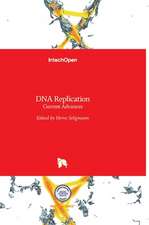Magnetic Quantum Dots for Bioimaging
Editat de Amin Reza Rajabzadeh, Poushali Das, Sayan Ganguly, Seshasai Srinivasanen Limba Engleză Paperback – 19 dec 2024
| Toate formatele și edițiile | Preț | Express |
|---|---|---|
| Paperback (1) | 417.32 lei 3-5 săpt. | +20.73 lei 7-13 zile |
| Taylor & Francis Ltd. – 19 dec 2024 | 417.32 lei 3-5 săpt. | +20.73 lei 7-13 zile |
| Hardback (1) | 1058.65 lei 6-8 săpt. | |
| CRC Press – 5 iun 2023 | 1058.65 lei 6-8 săpt. |
Preț: 417.32 lei
Preț vechi: 439.29 lei
-5% Nou
79.87€ • 83.16$ • 67.50£
Carte disponibilă
Livrare economică 14-28 februarie
Livrare express 31 ianuarie-06 februarie pentru 30.72 lei
Specificații
ISBN-10: 1032334916
Pagini: 291
Dimensiuni: 233 x 156 x 20 mm
Greutate: 0.43 kg
Editura: Taylor & Francis Ltd.
Notă biografică
Amin Reza Rajabzadeh is Assistant Professor and former Chair of the Biotechnology Program at the School of Engineering Practice and Technology, McMaster University, Canada. Dr. Rajabzadeh specializes in the field of biochemical engineering with a focus on biosensors, bioseparation and purification, bioprocess monitoring and control, bioreactor design, and environmental engineering. Dr. Rajabzadeh is a Professional Engineer of Ontario and is a member of the Canadian Engineering Education Association and the American Society for Engineering Education. Dr. Rajabzadeh was a MacPherson Leadership in Teaching and Learning (LTL) Fellow from 2017 to 2019.
Seshasai Srinivasan is Chair of the Software Engineering Technology program at McMaster University's Faculty of Engineering. Prior to this, he held a Research Scientist and a part-time instructor position in the Department of Mechanical and Industrial Engineering of Ryerson University, a postdoctoral position at the Laboratory of Food Process Engineering of the Swiss Federal Institute of Technology (ETH-Zurich) in Switzerland and a Research Associate position in the Engine Research Center of the University of Wisconsin-Madison. He maintains a vibrant interdisciplinary research program in the areas of biosensors, quantum dots, Li-ion batteries, food rheology, and thermodiffusive flows.
Poushali Das is a senior postdoctoral research fellow at Bar-Ilan University, Israel. She completed her Ph.D. degree in 2019 from the Indian Institute of Technology, Kharagpur. Her research interests include multifunctional luminescent quantum dots and applications in sensors, antioxidant properties and the biomedical field, polymer/quantum dot nanocomposites, and MXene/polymer nanocomposites sonochemical synthesis of graphene-based nanocomposites.
Sayan Ganguly is a senior postdoctoral researcher at Bar-Ilan University, Israel. He obtained his Ph.D. from the Indian Institute of Technology, Kharagpur. His primary research interests include superabsorbent hydrogels, composite hydrogels, polymer-graphene nanocomposites, MXene-polymer systems, polymer composites for EMI shielding, and conducting polymer composites.
Cuprins
1. Introduction to Magnetic Quantum Dots. 2. Synthesis Approaches of Magnetic Quantum Dots. 3. Optical Properties of Magnetic Quantum Dots. 4. Characterization Techniques of Magnetic Quantum Dots. 5. History and Techniques of Bioimaging. 6. Fluorescent Magnetic Quantum Dots in Bioimaging. 7. Magnetic Quantum Dots for Magnetic Resonance Imaging (MRI) and Biomedical Applications. 8. A Siege Cancer Phototherapies by Magnetic Quantum Dots: An Overview, Challenges, and Recent Advancements. 9. Magnetic Quantum Dots for In-Vitro Imaging. 10. Magnetic Quantum Dots for In-Vivo Imaging. 11. Carbon Quantum Dots-Based Magnetic Nanoparticles for Bioimaging. 12. Cytotoxicity of the Magnetic Quantum Dots. 13. Challenges and Future Prospects of Magnetic Quantum Dots.



















